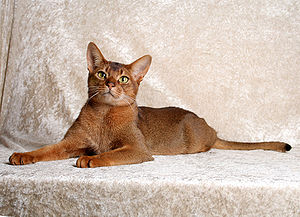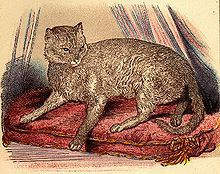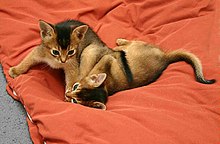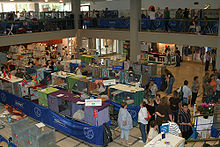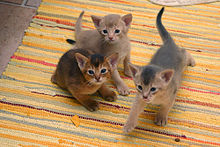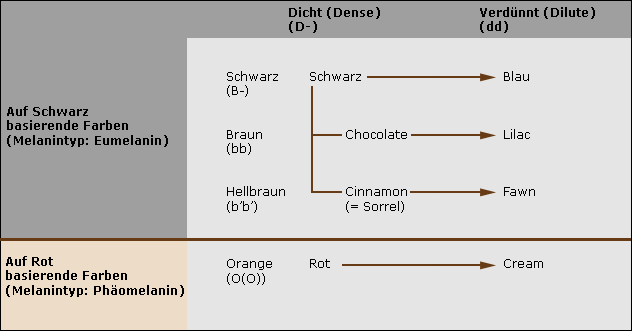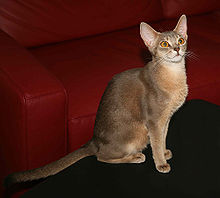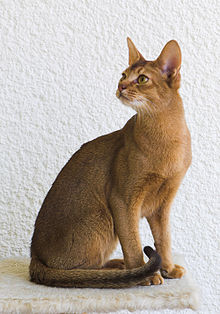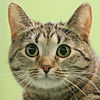Abyssinian cat
| Abyssinian cat | |||
|---|---|---|---|
|
|||
| Fur length: | Shorthair cat | ||
| Weight: | Male: 3.5 to 5 kg. Cat: 2.5 to 4 kg |
||
| generally recognized colors: | Wild colors Sorrel blue Beige fawn Black silver Blue silver Sorrel silver Fawn silver |
||
| not generally recognized colors: |
Chocolate Lilac |
||
| permitted coat pattern: | ticked (agouti) | ||
| not allowed coat drawing: | all fur drawings except ticked | ||
| Breeding standards: | |||
| List of cat breeds | |||
The Abyssinian cat (often used short form of the name: "Abyssinian") is one of the oldest bred cat breeds in the world. Although its name suggests Ethiopia , the former Abyssinia Empire , in East Africa as the country of origin, its origins lie in Southeast Asia .
The Abyssinian cat has been a breeding breed since the end of the 19th century. The main breeding areas today are the United States , Canada , Australia , Japan and Europe . Abyssinian cats are short-haired cats with different coat colors. A typical breed characteristic is a double, sometimes triple banding of the hair. This banding is known as ticking , the resulting fur pattern as the agouti effect. This is comparable to the coat patterns of wild hare and rabbit and brought the Abyssinian initially nicknamed "bunny cat" ( English : Hare Cat) one.
As part of the breeding of Abyssinian cats, half-long-haired Abyssinian cats also emerged around the middle of the 20th century. These are known as Somali cats and now form their own pedigree cat standard.
origin
The Abyssinian cat does not come from Abyssinia, today's Ethiopia, as its name suggests. The assertion that Abyssinian cats are descendants of the cats living in Pharaonic Egypt and worshiped there as divinely revered is also part of the legend .
The ancestors of today's Abyssinian cats almost certainly come from the jungles of Southeast Asia. The mutation of the tabby gene “Abyssinian tabby” (TA), which has long only occurred in this breed of cats, is found in cats on the coast of the Indian Ocean between Singapore and Sri Lanka , while it cannot be detected in Egypt and East Africa. Wildcat species in Eurasia, Asia and Africa that resemble the Abyssinian cat are the black cat ( Felis silvestris lybica ) and the tube cat ( Felis chaus ).
The well-known prehistory of the modern Abyssinian cat breed points in the same direction: Early illustrations in the English cat journal from the 19th century, which look similar to the Abyssinian cat, were referred to there as "Asian cats". A stuffed animal with characteristics of the TA gene from the 1830s still exists as an exhibit in the zoological museum of the Dutch city of Leiden . The grobgesprenkelte ruddy cat a ruddy modern Abyssinian also from the exterior looks very much like her, is referred to there as "Patrie, domestica India" (Indian domestic cat).
In individual cases there was probably a spread of the original type from Southeast Asia towards the Middle East or East Africa; so above all by English traders and colonial officials within the British Empire .
history
The history of the modern "Abyssinian" cat breed in Europe begins in 1868. An Abyssinian cat is first mentioned in a British cat book from 1874. A colored lithograph shows a cat with speckled fur named Zula and explains in the accompanying description: “Zula, Mrs. Captain Barret-Lennard's cat. The cat comes from Abyssinia as a result of the war. ”Since British troops left Abyssinia in May 1868 and the country came under the influence of Italy , it is reasonable to assume that Zula was the first Abyssinian cat to come to England in the wake of the English colonial army . How this cat got from Southeast Asia to what was then Abyssinia and whether there was a temporary population of cats with characteristics typical of Abyssinian is unknown.
No further details are known about Zula's historical fate in England . The new and hitherto unknown type of cat attracted a lot of attention from English cat breeders, especially due to the agouti effect of the fur . There were crosses with British shorthair cats, some domestic cats, some pedigree cats to counteract inbreeding . The first Abyssinian cats with silver coloring were a result of the crossbreeding . As early as 1871, an "Abyssinian" cat (probably Zula or her direct descendants) was exhibited at the first public cat show in the Crystal Palace in London and won 3rd prize overall. In 1882 the Abyssinian cat was officially recognized as a new breed of cat. The then President of the English National Cat Club, Harrison Weir , personally defined the breed standard for the Abyssinian cats in 1889. This makes them one of the oldest pedigree cats in the world, along with the Siamese and Persian cats . A few years after the definition of the breed standard, the first Abyssinian cats could be found in English stud books. Shortly after the beginning of the 20th century, Abyssinian cats came to the USA and were increasingly bred there. In 1911, Abyssinian breeding was recognized in the USA by the Cat Fanciers' Association (C. F. A.), which was then as now the largest registered office for pedigree cats in the USA.
In the first half of the 20th century, Abyssinian cat breeding continued to spread in Europe and the United States. In the 1930s, breeders on both continents increasingly worked on the selection of typical Abyssinian breed characteristics. In 1926, Major E. Sydney Woodiwiss, a well-known English breeder, founded the first Abyssinian Cat Club . In Germany in 1933 the first Abyssinian cats were registered with what was then the only German cat breeding association, the 1st German Noble Cat Breeders Association ( 1. DEKZV eV ).
There were setbacks in the further distribution and breeding of the Abyssinian cat due to the two world wars . In England, then the center of Abyssinian cat breeding in Europe, only 12 purebred Abyssinian cats and tomcat survived the Second World War . A feline leukemia - epidemic in the 1960s resulted in addition to the decline in the two post-war periods breeders and cat figures close to extending extinction of Abessinierkatzenrasse. Since the 1970s, there has been a slow consolidation of the population figures, which, however, are by no means similar to those of the currently popular cat breeds such as Maine Coon , Persian or Siamese cats.
Appearance
Abyssinian cats are often referred to as the "miniature form" of a puma because of their appearance or are also compared to wild cats . In the group of cats with fur patterns, they belong to the so-called "ticked tabby cats", in which the pattern of the fur has been almost completely displaced by the agouti effect. Due to the influence of breeding, the tabby pattern is only recognizable on the head in the form of the eye rims and an M-shaped coat on the forehead. In the ideal case, Abyssinian cats are completely free of all known drawing patterns such as tentacles, currents or spots.
The Abyssinian cat is a slender, muscular, short-haired cat of medium size. The cats weigh between 2.5 and 4 kg, the male between 3.5 and 5.0 kg. Because of its long legs, like the Oriental Shorthair or Siamese, it is one of the long- legged cat breeds. The legs end in small oval paws with solid colored pads. The tail is relatively long, broad at the base and narrowly tapering.
The head has a moderate wedge shape and sits on a long, slender neck. The profile has a gentle contour and the snout is not clearly pointed. The medium-length bridge of the nose is gently curved, without a stop (abrupt transition from the snout to the forehead) or "Roman nose" (outwardly curved nose). The ears are set far apart and sometimes still have tufts of ears, comparable to those of the lynx . They stand upright, are large in relation to the head and slightly rounded at the tips.
The eyes are large, almond-shaped and outlined on the inside in the same basic color as the ticking and then outlined in light on the outer area of the eye area. The wide-set eyes can be either amber (sometimes referred to as "yellow"), nut brown, or green in color.
The short fur is close and has little undercoat. The so-called eel line runs on the back , a continuous dark stripe of color in the fur that ends in the dark tip of the tail. On the hind legs up to the heel, a dark section of hair continues in the color of the overall color as so-called "sole stripes".
The special breed characteristic of the Abyssinian cats, the "ticking" of the individual hairs, cannot be overlooked. As a rule, each hair is banded two, sometimes three or even four times, which is also known as "ticked" in technical terms. Which colors alternate in the banding depends on the color of the respective Abyssinian cat (see section " Colors "). However, the tip of the hair always has the darkest color shade. Only the hair of certain areas of the body is ticked: that of the head, the entire back and flank area, the tail and that on the outside of the legs. The hair on the underside of the body with the chest, stomach and the insides of the legs are uniformly colored in the basic color.
In young Abyssinian kittens, the ticking of the hair does not appear until the sixth week, when the woolly baby fur is gradually detached from the youth fur. Due to the ticking, the entire fur of the Abyssinian cat appears uniformly patterned and similar to that of a wild rabbit or hare . One speaks here of the agouti effect, whereby the term agouti (alternative spelling: agouti ) was named after the rodent genus Dasyprocta ( agouti ). The ticking of the hair in Abyssinian cats is inherited as a homozygous dominant trait (see genotype under the section " Colors ")
character
The Abyssinian cat is an intelligent and lively cat. A distinctive characteristic of the Abyssinian cat is its curiosity. She often follows her human caregivers at every turn and observes and examines all activities very carefully. In general, Abyssinian cats are very people-oriented but still independent, balanced and sociable. A certain simplicity in general dealings and a high level of stress tolerance are certified as further positive character traits. However, especially at a young age, she has a lively temperament with a great urge to move, which she likes to live out together with other cats. It is therefore not advisable to keep cats alone. She also gets along very well with domestic dogs . Another characteristic of the breed is the very quiet voice of the Abyssinian cats and their rather low need for acoustic communication.
When living together with other cats, the Abyssinian cat often occupies a dominant position. But she is considered very social and agreeable. There are many known cases where Abyssinian cat mothers raise their offspring together.
Breed standards and breeding
In 1882 the Abyssinian cat was officially recognized as a cat breed in England. The first binding breeding standards were published as early as 1889, and in 1896 the first Abyssinian cats were registered in the stud book of the British National Cat Club. In 1907 the first pair of Abyssinian cats came to the USA. Systematic breeding there (especially from around 1930) resulted in a parallel development of Abyssinian cats in the USA and in Europe, especially in England. In 1911 the Cat Fanciers Association (C. F. A.) finally recognized the Abyssinian cats in the USA. In 1933 the first Abyssinian cats were officially registered in Germany.
Today there are slightly different versions of the breed standard in the large national and international umbrella organizations of pedigree cat breeding associations. For Europe, the F. I. Fe ( Fédération Internationale Féline ) should be mentioned as the largest umbrella organization. In the USA, the C. F. A. (Cat Fanciers' Association) and T. I. C. A. ( The International Cat Association ) are among the larger umbrella organizations.
| Breed standard Abyssinian cats using the example of the Fédération Internationale Féline (Category III - shorthair & somali) | ||
|---|---|---|
| body part | feature | description |
| head | shape | Wedge-shaped with balanced proportions, wide at the top, with gently and gracefully shaped contours |
| nose | Medium length nose, in profile the bridge of the nose is gently curved without a stop or straight bridge of the nose | |
| chin | Firm and well developed, rounded | |
| snout | Not clearly pointed. A shallow indentation that forms the snout is desirable. A pinch counts as a mistake. | |
| Ears | shape | Relatively large and broad at the base, slightly rounded at the tips. A drawing (“wild mark”) is just as desirable as tufts of hair on the tips of the ears |
| location | Clearly set apart, attentively erect | |
| eyes | shape | Large, almond-shaped and clearly set apart |
| colour | Shiny and expressive, amber, green or yellow, of pure, strong color. Outlined with the same basic color of the ticking. | |
| neck | shape | Graceful |
| tail | shape | Quite long and tapering to a point, broad at the base |
| body | anatomy | Of medium length and compactness, strong, supple and muscular. Overall athletic build. |
| hide | structure | Short, fine, soft and closed, tight-fitting. |
| colour | 2 or 3 ribbons on each hair, with dark tips as standard. | |
| badge | White markings are tolerated on the chin and right on the nose. | |
error
Errors in Abyssinian cats include too many markings on the face, ears that are too small or too pointed, and eyes that are too round. A pinch in the head area, an indentation in the cheek area above the whisker pad, is also undesirable. Ring drawings on the tail are just as undesirable as so-called ghost drawings or other fur drawings on the body or legs.
Other faults are, for example, a head that is too round, ghost drawings on all four legs or a too thin, whip-shaped tail. Closed neck rings (uninterrupted dark-colored rings on the neck), markings on the chest and stomach or missing or insufficiently pronounced ticking of the hair are further examples of defects in the coat. Abyssinian cats, which show the mentioned defects, have no prospect of title awards such as champion or international champion at a pedigree cat show .
breeding
In most pedigree cat breeding clubs, Abyssinian cats are allowed to be mated from the age of 12 months, sometimes even from 14 months. The litter size is one to four kittens, but statistically the most common are two kittens per litter. This also leads to the relatively low distribution of Abyssinian cats compared to the better known cat breeds such as the Siamese cats (four to six kittens per litter).
Abyssinian cats may only be crossed with one another. Foreign cat breeds are not permitted as crossbreeding partners. In the breeding of Somali cats , the only permitted cross partner is the Abyssinian cat. The resulting cats are so-called "Abyssinian Variant", heterozygous Abyssinian cats with the recessive gene for long hair. Abyssinian variant kittens are currently only used by most Somali cat breeders for the breeding of Somali cats, since in Abyssinian cat breeding no genetic predispositions for long hair are desired.
When crossing the Abyssinian cat breed, as with some other cat breeds, the blood groups of the breeding animals must be taken into account, otherwise the offspring may die . There are three blood groups in Abyssinian cats: A (almost 95%), B and AB (each <3%, see statistical information). With certain blood group combinations, such as blood group B × A (A / A, pure-bred homozygous), so-called feline neonatal isoerythrolysis (FNI, “fading kitten syndrome” or “kitten mortality”) and death of the animals occurs in all offspring .
Only members of a recognized pedigree cat breed club, which in turn can be affiliated to one of the larger umbrella organizations, can officially breed. There you register your kennel name (breeding name, English: cattery). This is a one-time assigned and registered breed name, e.g. B. from Abydos-Menes . The breeder is solely responsible for selecting the kennel name as well as the names of the individual cats derived from them that result from the breeding in this kennel. Its own association provides the Abyssinian cat breeder with the pedigree for the animals in his kennel. This means that cats can also be exhibited and awarded prizes in national and international pedigree cat shows.
Colours
In Abyssinian cats, too, the colors in the hair, skin or eyes are caused by the presence of melanin , especially in the respective hair shafts. The variability of the melanin structure in shape, size or arrangement results in a variability of the colors. Of the two melanin types eumelanin (strong light absorption, dark pigmentation) and pheomelanin (weak light absorption, pigmentation in the red-orange and yellow area), only colors based on eumelanin are accepted in Abyssinian cats. Most color variations occur with this type of melanin. In the breeding history of the Abyssinian cats, this led to the development of four basic colors based on eumelanin:
- Wild colors (ruddy, usual, tawny, lièvre)
- Blue (blue)
- Sorrel (cinnamon, red)
- Fawn (beige-fawn)
Description of the genotype of a homozygous wild-colored Abyssinian cat: AABBDDT a LL
AA = agouti effect, basic color and ticking (present in all Abyssinian cats)
BB = black pigmentation
DD = intensive (“dense”) pigmentation
T a = “Abyssinian tabby”, dark pattern on agouti fur. In this genetic form reduced patterning. Occurs only on the face and head, ideally not on the rest of the body. Dominant over other tabby alleles.
LL = homozygous short-haired
Generally recognized colors
When it comes to the recognition of some of the black-based color variants (chocolate, lilac), the aforementioned umbrella organizations have different levels of acceptance. However, all associations recognize the four main colors (wild, sorrel, blue and beige-fawn) and - apart from the CFA - also their silver variants.
Wild colors (ruddy, usual, tawny, lièvre)
- Body color: warm reddish brown with black ticking
- Basic color: dark apricot to orange
- Ear tips: black
- Tail tip: black
- Paw pads color: black or dark brown
- Nose mirror: brick red with black border.
Original color of the Abyssinian cats. All other colors and color variations are the result of mutations of this color.
Blue (blue)
- Body color: warm blue-gray with dark steel-blue-gray ticking
- Basic color: light, fawn (beige) / cream
- Ear tips: dark steel blue-gray
- Tip of the tail: dark steel blue-gray
- Color of the paw pads: dusky pink / blue-gray
- Nose mirror: dusky pink with a dark steel-blue-gray border
Blue is the diluted form of wild colors and the result of a mutation in the gene that is responsible for the intense coloration ("Dense coloration"). The color name does not mean the color blue in the narrower sense, but rather different intense shades in the shades of blue-gray.
Sorrel (cinnamon, red)
- Body color: bright warm copper red with chocolate brown ticking
- Basic color: dark apricot
- Ear tips: red-brown
- Tip of the tail: red-brown
- Paw pads color: pink
- Nasal mirror: light red with a red-brown border
The color Sorrel should not be confused with the genetically determined color red. As with the not generally recognized color chocolate, Sorrel was created by mutations of the gene for the color black (here corresponding to wild colors), whereby it is inherited recessively in relation to black and chocolate.
Fawn (beige-fawn)
- Body color: dull matte beige with dark, warm cream colored ticking
- Basic color: light cream
- Ear tips: dark warm cream
- Tip of the tail: dark warm cream
- Paw pads color: pink
- Nasal mirror: pink with old pink border
Fawn is the diluted form of Sorrel and originated in the same way as the color blue.
Silver variants
All of the colors mentioned above also exist in silver. There the basic color as well as the lower hair is a pure silver white. The ticking color as well as the color of the paw pads and the nose mirror correspond to the colors mentioned above. The silver variant of the color wild colors is called "black silver", while for all other colors the designation silver is appended to the color name (Sorrel silver or Sorrel silver)
Not generally recognized colors
The Fédération Internationale Féline (FIFé) has not yet recognized the colors Chocolate and Lilac, while this is already the case, for example, with the Governing Council of the Cat Fancy (GCCF), the World Cat Federation (WCF) and smaller associations. The color chocolate, like Sorrel, goes back to mutations in the gene for the color black, which are believed to have reduced the number of eumelanin pigments in the hair shafts and changed their shape. Lilac is the diluted form of the color chocolate and the result of a mutation in the gene that is responsible for the intense color.
Chocolate (chestnut)
- Body color: Warm apricot with chocolate brown ticking
- Basic color: strong apricot
- Ear tips: chocolate brown
- Tip of the tail: chocolate brown
- Paw pad color: cinnamon
- Nose mirror: old pink with a chocolate-colored border
Lilac
- Body color: Warm beige tone with lavender ticking
- Basic color: warm cream tone
- Ear tips: Brownish with blue tones
- Tip of the tail: Brownish with shades of blue
- Color of the pads of the paws: old pink to lavender with a light blue color
- Nose mirror: old pink with a light blue color and a lavender border
Diseases
For the common cat diseases see the corresponding chapter Diseases in house cats. In addition, there are special diseases in Abyssinian cats (and the genetically almost identical Somali cats) that have not yet occurred in other pedigree cats (pyruvate kinase deficiency) or less often.
Hereditary Diseases
Progressive retinal atrophy
The progressive retina - atrophy ( "retinal atrophy," PRA) is to be understood as a clinical collective term for degenerative retinal anomalies. In Abyssinian and Somali cats, this is understood to be a genetically determined, recessively inherited rod - cone - degeneration . The retina of the eye (retina) is continuously and progressively destroyed by local metabolic disorders in the tissue of the retina. A common first symptom of PRA is the onset of night blindness .
A distinction is made between two forms of PRA in Abyssinian cats: In the degenerative form (recessive inheritance), visual disturbances occur from the age of 2 onwards. These lead to a slow later blindness of the animals. The onset of the disease is possible in cats up to and including the age of six, after which it can be assumed that the genetic predisposition of the animal is carrier-free. An annual examination for this disease is therefore required for breeding animals from the age of 18 months up to the age of six. By strictly adhering to the test procedures and targeted breeding, this disease is now much less common in Abyssinian cats. In general, in addition to the Abyssinian cats, all cat breeds with the coat colors cinnamon and fawn or the drawing pattern ticked tabby are PRA-endangered. In the dysplastic form (dominant inheritance), even very young cats show a visual impairment that leads to complete blindness within a year.
A suitably trained and authorized veterinarian can test for retinal atrophy using ophthalmological examination methods. By atropine reproducing the pupils are dilated and the vet can examine the retina, these studies should be carried out every two years until the age of six.
Analogous to DNA tests for PRA and the use of DNA markers in various dog breeds ( Welsh Corgie , Mastiff and others), which have been used successfully in practice for some time, efforts have been made to also provide such a test for Abyssinian and Somali cats to develop. The advantages would be the high diagnostic reliability, the relatively simple and one-time implementation of a DNA test for PRA and the fact that only one parent animal has to be tested for PRA-free in degenerative PRA. Since mid-2007 the company Laboklin (laboratory for clinical diagnostics) has been offering a PRA genetic test for Abyssinian and Somali cats. This can be combined with a test for pyruvate kinase deficiency. The genetic test can optionally be carried out using a blood sample ( EDTA blood ) or a cheek swab using special brushes. The duration of the investigation is stated to be three days after receipt of the sample, and the result is that animals are categorized as “free”, “carrier” and “affected”.
Pyruvate kinase deficiency
The pyruvate kinase (PK deficiency) is an inherited disease that to a special form of anemia ( anemia leads). In addition to humans and dog breeds, mainly Abyssinian and Somali cats are affected.
Primarily, cats suffering from this disease lack the pyruvate kinase enzyme in the red blood cells ( erythrocyte ), which is necessary there for energy production. The resulting disturbance in the successive enzymatic reactions of glycolysis (splitting of the energy carrier glucose ) leads to a greatly reduced lifespan of the red blood cells, which are normally viable for around 70–120 days. This leads to chronic regenerative hemolytic anemia , a form of anemia in which the number of red blood cells is too low due to their increased breakdown due to their short lifespan.
If an Abyssinian cat suffers from a pyruvate kinase deficiency, two stages can be distinguished: the intermittent phase, which occurs in phases, and the so-called "hemolytic crisis" triggered by external factors such as stress. In the latter form, blood transfusions can save lives, but there is no general therapy for pyruvate kinase deficiency. Investigations in the USA in 2000 revealed a pyruvate kinase deficiency in Abyssinian cats as early as six months and up to 12 years of age. Surprisingly, older, sick animals were also found that were asymptomatic, that is to say free of symptoms.
Pyruvate kinase deficiency in Abyssinian cats is autosomal , i.e. not linked to the sex of the hereditary animal, and is inherited recessively. As the genetic defect in Abyssinian cats is known, they can be reliably tested for PK using a DNA test. Carriers of the genetic defect themselves do not suffer from pyruvate kinase deficiency. When breeding, two carrier animals should therefore never be paired with each other, which, however, is not always followed in breeding circles.
Renal amyloidosis
In the renal amyloidosis (RA) is a metabolic disorder , which are not degradable in the deposition proteins (amyloids) primarily in the kidney leads. The disease usually breaks out between the ages of four and seven and is found in 75% of all cases of hangover. As the disease progresses, chronic kidney failure (CRF) occurs and the animal usually dies. An early diagnosis is so far only possible to a limited extent. In addition, a large number of kidney diseases with similar symptoms (but without amyloid deposits in the kidney tissue) reduce the diagnostic confidence. A biopsy of kidney tissue in living animals is possible, but the result is more likely to be classified as an unreliable diagnostic method. Renal amyloidosis can therefore usually only be reliably determined in dead animals by staining the examined tissue with the so-called "Congo red test". Renal amyloidosis is not particularly common in cats. The susceptible cat breeds primarily include the Abyssinian and Somali cats, more rarely Siamese and Thai cats as well as the Oriental Shorthair (OKH).
In specialist circles it is not yet definitely clear whether the causes of renal amyloidosis are genetically inherited. Based on the research results so far, however, a recessive inheritance of the disposition is assumed. European Abyssinian cat breeders also support research groups for renal amyloidosis (for example at the Utrecht University Hospital, Netherlands) by providing test results, breeding data and blood samples for further research and possible development of a DNA test for RA.
Patellar luxation
The patellar luxation (PL) is a deformation of the knee joint or the kneecap . This has the consequence that it comes to a temporary or permanent kneecap dislocation. There are four degrees of dislocation here. Depending on the degree of impairment, the affected leg can no longer be properly loaded and angled. The symptoms of patellar luxation in Abyssinian cats can vary widely. The dislocation of the kneecap can occur briefly and "straighten" itself again (grade II of the patellar dislocation). If it lasts longer, the cat can pull the thigh of the affected leg towards the body or stretch the affected leg so that the foot does not touch the ground. Both hind legs can also be affected by a patellar luxation at the same time.
The patellar luxation can only be detected in adult cats by a veterinarian using manual extension and flexion tests of the extremities, whereby the affected animals can be operated on. According to current scientific knowledge, the patellar luxation is inherited as recessive polygene . There seems to be a link between the gene for patellar luxation and the Sorrel and Fawn colors. Affected animals are therefore not suitable for breeding .
Abyssinian cats in genome research
The genome of the Abyssinian cat has been almost completely sequenced since 2007 . A team of scientists from the National Cancer Institute, Frederick , USA, identified a total of 20,285 potential genes from a DNA sample from an adult female Abyssinian cat.
The decoding of the genome is intended to facilitate comparative studies of genetically inherited diseases that occur in both cats and humans. One example is the eye disease retinopathia pigmentosa , which affects 30,000 to 40,000 people in Germany. In addition, cats are considered to be good model creatures for research into infectious diseases such as AIDS because they contain the FIV pathogen, a virus that is closely related to HIV .
References
- ↑ M.D. Stables, William Gordon: Cats - Their Points and Characteristics, with Curiosities of Cat Life, and a Chapter on Feline Ailments . Dean & Son, London 1876.
- ↑ Early Abyssinian Standard from 1889 ( Memento from June 29, 2011 in the Internet Archive )
- ↑ Blood groups in cats ( Memento of the original from July 20, 2006 in the Internet Archive ) Info: The archive link was inserted automatically and has not yet been checked. Please check the original and archive link according to the instructions and then remove this notice.
- ^ Cat Color Genetics and Pigmentation
- ↑ Dortmunder Kreis (DOK) - Society for Diagnostics of Genetically Determined Eye Diseases
- ↑ Website Laboklin - Genetic Test for Progressive Retina Atrophy (rdAc-PRA) in Abyssinian and Somali cats
- ↑ Urs Ginger: “Erythrocyte pyruvate kinase deficiency as a cause of intermittent (relapsing) anemia in Abyssinian and Somali cats”. In: RAS - Pedigree Cat Journal for Abyssinians and Somalis. Issue 4, Volume 14, 2001, pp. 13-14.
- ↑ RA (Renal Amyloidosis) ( Memento of the original from July 20, 2006 in the Internet Archive ) Info: The archive link was inserted automatically and has not yet been checked. Please check the original and archive link according to the instructions and then remove this notice.
- ↑ JU Pontius, JC Mullikin u. a .: Initial sequence and comparative analysis of the cat genome. In: Genome Research. 17, 2007, p. 1675, doi: 10.1101 / gr.6380007 .
- ↑ X- rayed cats - Researchers publish the genome sequence of the house cat. In: Wissenschaft.de. November 1, 2007, accessed September 8, 2019 .
literature
- Edeltraut Voigt: Abyssinian cats . Verlagsgesellschaft Rudolf Müller, Cologne 1982, ISBN 3-481-21151-1 .
- Edeltraut Voigt: Abyssinian cats. Purchase, attitude, care . Verlag Neumann-Neudamm, Melsungen 1993, ISBN 3-7888-0950-7 .
- J. Anne Helgren, J. Anne Hauppauge: Abyssinian Cats. Everything about Acquisition, Care, Nutrition, Behavior, Health Care, and Breeding . Barron's Educational Series. Barron's, Hauppauge NY 1995, ISBN 0-8120-2864-3 .
- Kate Faler: This Is the Abyssinian Cat . TFH Publications, Neptune 1983, ISBN 0-87666-866-X .
- Ruth Cooke-Zimmermann: Abyssinians (Kw Series). TFH Publications, Neptune 1992, ISBN 0-86622-197-2 .
Web links
- RAS-Journal - Pedigree cats journal for Abyssinians and Somalis
- Fédération Internationale Féline - Abyssinian Standard, as of January 1, 2015 (English, PDF; 133 kB)
- The Cat Fanciers' Association - Breed Profile: Abyssinian (English)
- Cattery Nile Abyssinians - Article: "Practical Color and Coat Length Genetics for Abyssinian & Somali Breeders" ( Memento from April 30, 2013 in the Internet Archive )
- Eros. - Electronic Register of SOMALIS pedigree database Abyssinian and Somali cats (English)
- The History Project: Abyssinian - History and historical images of Abyssinian cats
